Southwest Michigan fruit regional report – May 7, 2013
Tree fruit are blooming, plant growth has been very rapid and soils are drying.
Weather
Last week was warm with highs in the 70s and 80s. Low temperatures were in the 50s. Plant growth has been rapid with stone fruit blooming. Leaves are emerging and expanding rapidly. This week will continue warm with highs in the 70s and lows well above freezing. There is a good chance of rain showers later this week with the passage of a cold front. Michigan State University Extension suggests growers apply protective fungicides ahead of wetting events.
Based on tree fruit bloom, we are four or five days behind normal (see “2013 bloom dates for southwest Michigan tree fruit crops”). Passage of a cold front this weekend will bring the risk of a frost or a freeze on Sunday or Monday morning (May 12-13). At bloom, temperatures below 29 degrees Fahrenheit can kill the blossoms (see “Freeze damage depends on tree fruit stage of development”). We are near the end of the freeze season or the period in time when freezing temperatures are likely (see “Probability of a hard frost or freeze in the spring for some southwest Michigan fruit sites”). Soils are drying out and warming rapidly. You can check your local weather station and conditions at Enviro-weather.
Southwest Michigan GDD summary from January 1 to May 5 |
|||
|
Station |
GDD 42 F |
GDD 45 F |
GDD 50 F |
|
Benton Harbor (SWMREC) |
333 |
256 |
160 |
|
Fennville (TNRC) |
285 |
213 |
136 |
|
Average for the region |
330 |
255 |
159 |
|
Regional ten year average |
468 |
363 |
228 |
Tree fruit
Fruit have moved very rapidly with the warm weather. Soils are drying out as the trees use the soil moisture to support the rapid growth. Drier, sandy soil conditions recently have slowed fertilizer uptake, resulting in paler than normal foliage in some sites. Stone fruit are blooming or are past bloom. Insect activity is increasing. Oriental fruit moth adults have not yet been caught. Growers should not use insecticides during bloom. Controls for blossom brown rot are needed at bloom on stone fruit. Blooming apples and pears are susceptible to fire blight.
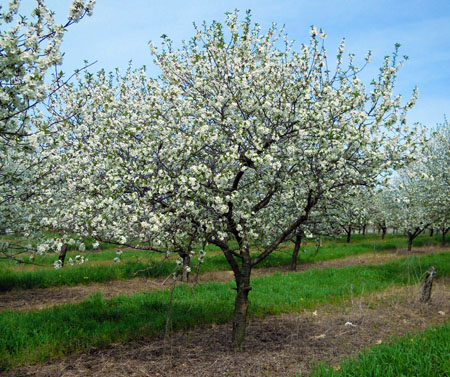
Montmorency tart cherry trees are in full bloom in southwest Michigan.
Photo credit: Mark Longstroth, MSU Extension
Apricot bloom is ending; most fruit is in the shuck.
Peaches are blooming. Full bloom was May 1 in showy varieties in Berrien County, with non-showy bloom types in full bloom one to two days later. Growers have been using brushes, tractor-powered Darwin string thinners and handheld Cinch thinners to reduce blossom numbers.
Due to the dry conditions, growers who are using copper to reduce bacterial canker should use caution. Do not continue to apply copper sprays if there has been no rain between sprays as the accumulated copper can cause copper toxicity.
In cherries, sweet cherries bloomed last week and are generally past full bloom. Sweet cherries hold on to their petals for a long time after bloom, but new shoot growth is beginning to hide the old blossoms.
Tart cherries are in full bloom. More damage to cherry fruit buds from the April 20-21 low temperatures is being reported in southern Berrien County as growers inspect their orchards. Fungicide programs for cherry leaf spot are needed following bloom when leaves develop functional stomata (air-exchange pores), which allow the fungus to infect the leaves.
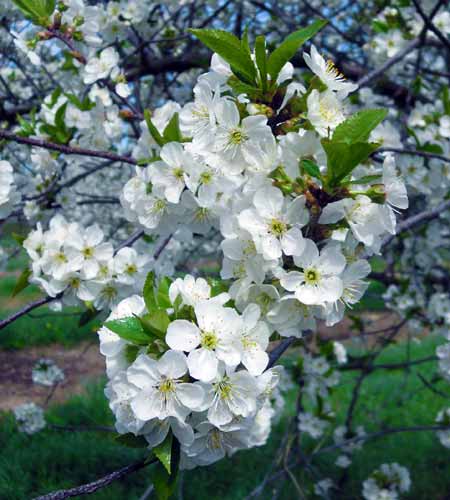
Most tart cherries show little damage from the freeze on April 21.
Photo credit: Mark Longstroth, MSU Extension
In plums, Japanese plum bloomed last week. European plums are blooming now. Black knot controls are needed until active shoot growth slows in early to mid-summer. The most important fungicide treatment time for this disease is from first white on flower buds until about three weeks later.
Apples range from pink to first bloom in Berrien County. In Van Buren County, apples are generally at pink. With the warm conditions, bloom should be widespread by mid-week. Temperatures above 65 F during bloom increase fire blight (Erwinia amylovora) bacteria populations in open blossoms. The epiphytic infection potential (EIP, a measure of the bacterial population) is predicted by the Maryblyt model on Enviro-weather. An EIP over 100 with a rain can result in a fire blight blossom infection. Using May 6 as the first bloom date for apples, the epiphytic infection potential is predicted to be close to 100 on Thursday, May 9. Apogee applications to reduce the spread of fireblight after infection need to be applied at full bloom. This will be later this week.
Overwintering obliquebanded leafroller larvae should be active on shoot tips and flower clusters and then move throughout the tree.
Pears are at full bloom. Bloom started on May 3-4. Temperatures above 65 F since bloom opened have resulted in buildup of fire blight bacteria populations in open blossoms, as predicted by the Maryblyt model on Enviro-weather. The EIP will reach 100 by Tuesday, May 7, for the SWMREC station in Berrien County, using a first bloom date of May 4. An EIP over 100 with a rain predicts a fire blight blossom infection for pears. Insecticides for pear psylla management need to wait until bloom ends.
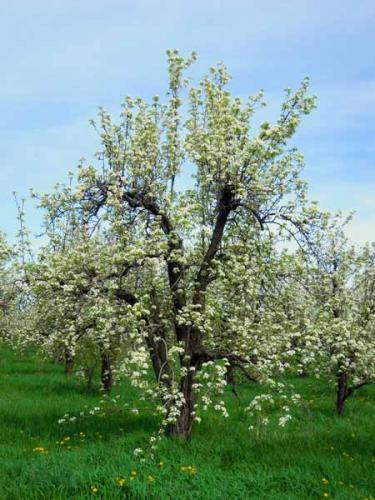
This ‘Bartlett’ pear tree is in full bloom and at risk for
a fire blight blossom infection if we have a warm rain during bloom.
Photo credit: Mark Longstroth, MSU Extension
Small fruit
In grapes, ‘Concord’ and ‘Niagara’ buds have burst with 1-inch shoots. There are a good number of doubles where both the primary and secondary buds are growing. ‘Marquette’ grapes at Southwest Michigan Research and Extension Center have 1- to 3-inch shoots. Other wine grapes range from early swell to budburst.
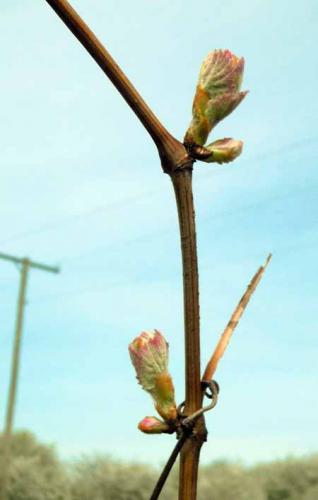
Double buds where both the primary and
secondary shoot buds are growing is a common
sight in southwest Michigan. Photo credit: Mark Longstroth, MSU Extension
We found considerable grape flea beetle activity and feeding injury in Concord, less in other varieties. Check your vineyard for grape flea beetle activity this week. Climbing cutworm is another early season pest that may be active now. Cool nights are favorable for cutworm feeding and they prefer weedy sites with sandy soils.
Pre-emergence herbicides should be on now. Check the 2013 Michigan Fruit Management Guide (E154) for recommended herbicide products. With grapes at bud burst, be cautious about glyphosate in tank-mix applications with pre-emergence herbicides.
Blueberries are at pink bud. Early varieties are at late pink bud approaching bloom. Late varieties are past bud burst and green leaf tissue is unfolding. Bloom in early varieties should begin this weekend.
As leaf tissue emerges, primary mummy berry infections are still possible. New mushrooms have been reported and growers should be scouting for mummy berry mushrooms. Spores are generally released under dry conditions, not during rains, but free water is required for the spores to germinate and begin infection. See “Managing mummy berry shoot strike infections” for more information on the infection on mummy berry shoot strike and fungicide sprays for mummy berry control.
Strawberry flower trusses are emerging from the crown. We will be watching for strawberry bud weevil (clipper) and tarnished plant bugs as flower buds emerge. Everbearing strawberries in the high tunnels are growing well and more varieties have open flowers than last week.
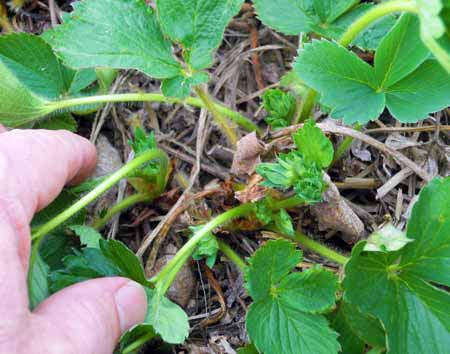
Strawberry flower trusses (flower clusters) are emerging from the crown of the plant.
The individual flower buds can be killed by temperatures of 27 F.
Photo credit: Mark Longstroth, MSU Extension
Bramble shoots are 2 to 4 inches long and leaves are out, but flower buds are not visible. New primocanes are beginning to emerge from the ground. Fall-bearing raspberries have been mowed. Lime sulfur treatments for anthracnose are being applied. High-tunnel raspberries are more advanced than raspberries in the field.
Upcoming meetings
The next Monday fruit IPM meeting is on May 13 at Fruit Acres Farms at 5 p.m. These weekly meetings are good for one RUP credit and will continue through the end of June.
Two Blueberry Twilight Meetings will be held on May 9 in Van Buren County and May 14 in Ottawa County. There is no charge for the meetings and two RUP credits will be available. For more information, contact Mark Longstroth.
The next Grape IPM meeting series is May 22, 6 to 8 p.m., at Cronenwett Farms, 70121 28th St., Lawton, MI 49065 (view map).
A half-day workshop on weed identification and management in grapes is scheduled at SWMREC June 6 from 11:30 a.m. to 5:30 p.m. and tentatively at the Northwest Michigan Horticultural Research Center (NWMHRC) June 7 from 11:30 a.m. to 5:30 p.m. Registration is $25 and includes an outdoor, hands-on weed identification lab, demonstration on how to properly calibrate a herbicide sprayer, cultural controls for weeds and information about the effectiveness of herbicides against particular weeds. Lunch, handouts and RUP credits are included. Contact Diane Brown or Jamie Styburski at 269-944-4126 for more information about the meeting at SWMREC, and Duke Elsner at 1-231-922-4822 for more information about the meeting at NWMHRC.



 Print
Print Email
Email




